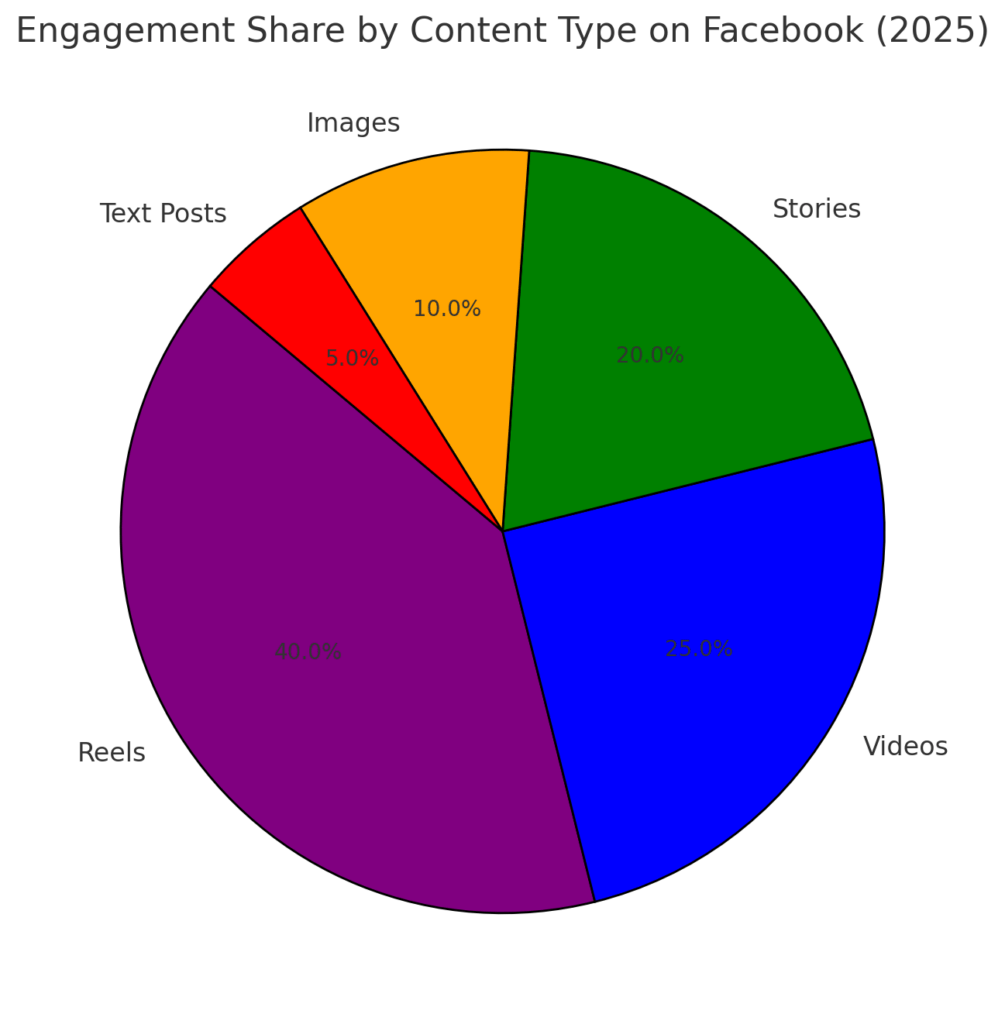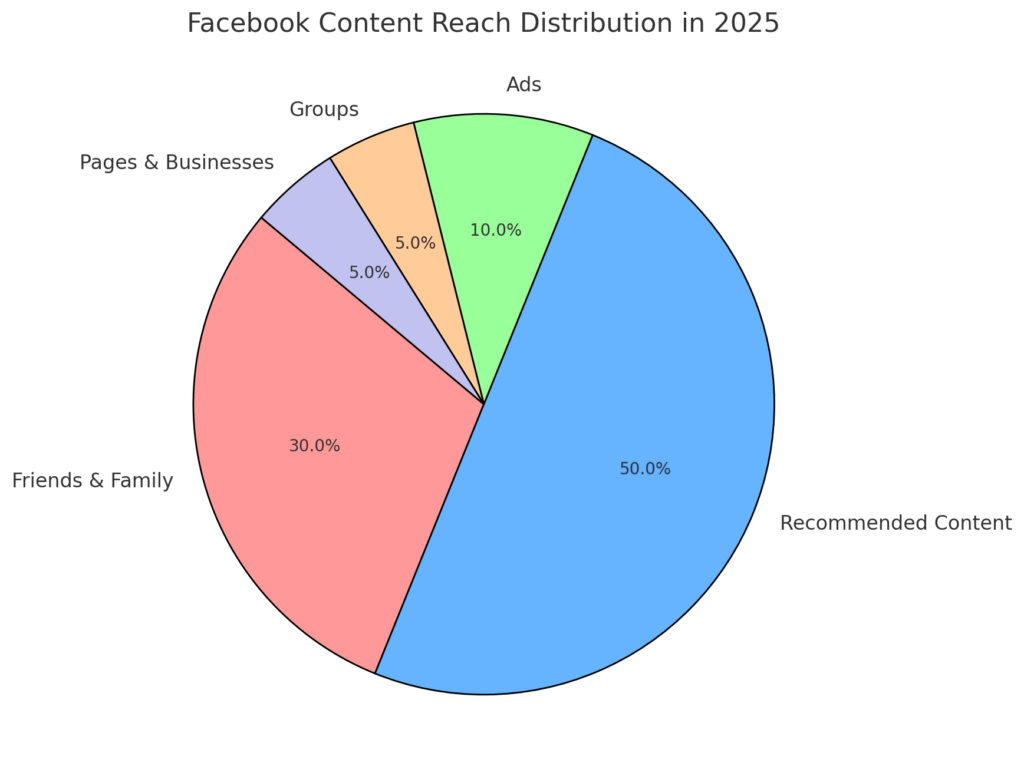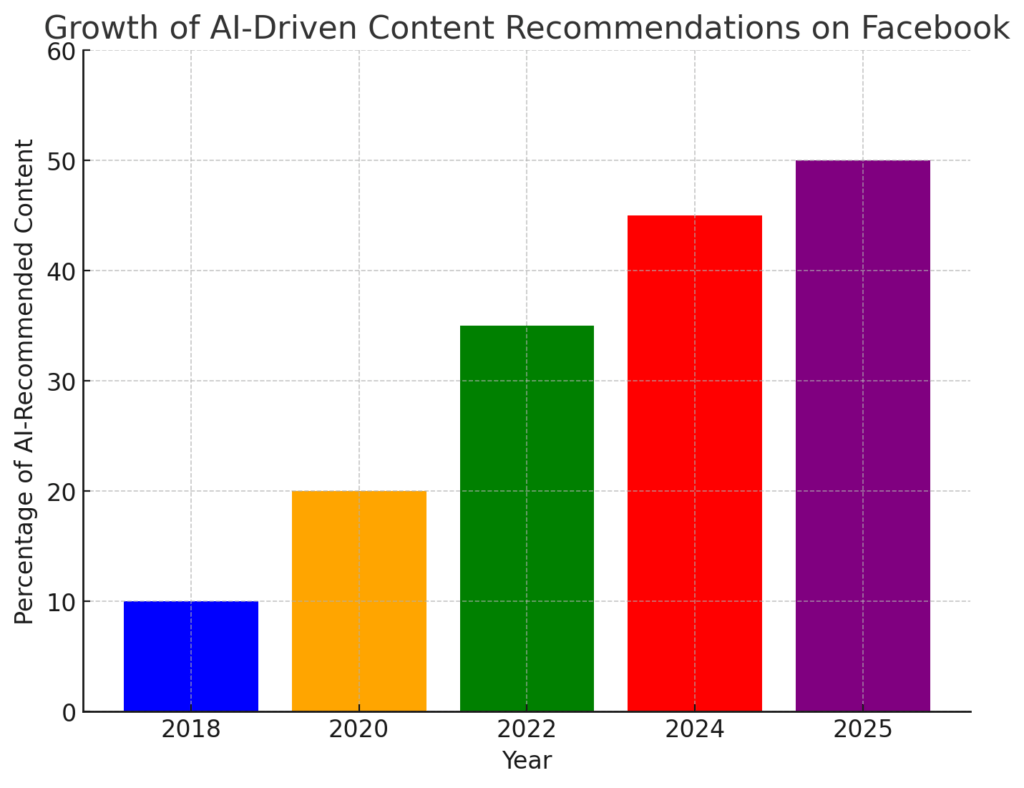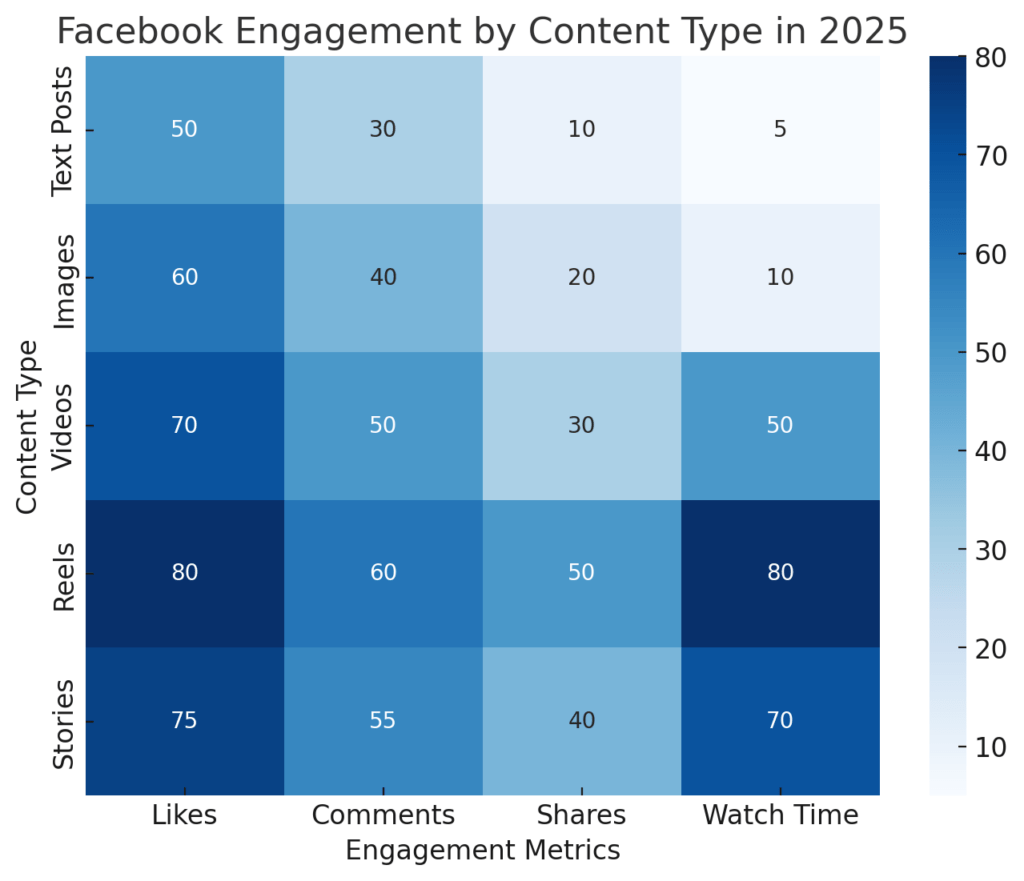
25 Mar TOP FACEBOOK ALGORITHM STATISTICS 2025
Facebook’s algorithm has undergone major transformations over the years, shaping the way billions of users interact with content. From its early EdgeRank system to the sophisticated AI-driven models of 2025, each update has influenced engagement, advertising, and even political discourse. While these advancements have made content discovery more personalized and efficient, they have also raised concerns about privacy, misinformation, and algorithmic bias.
As Facebook continues refining its ranking system, the implications extend beyond social media, affecting businesses, content creators, and the broader digital ecosystem. Understanding these shifts is crucial for anyone navigating the platform, whether for marketing, news consumption, or social interactions. Looking ahead, balancing engagement optimization with ethical considerations will be a defining challenge. In this analysis, we’re diving into 20 key statistics about Facebook’s algorithm. Amra and Elma has carefully gathered the data, providing insights into past changes and what they might mean for the future.
TOP FACEBOOK ALGORITHM STATISTICS 2025 (Editor’s Choice)
Facebook’s algorithm has undergone significant transformations over the years, adapting to user behavior, technological advancements, and the platform’s evolving objectives. Below are 20 key statistics and insights that highlight the evolution of Facebook’s algorithm over time and its state in 2025:
1. Introduction of EdgeRank (2009): Facebook introduced the EdgeRank algorithm to determine the visibility of posts in users’ News Feeds. EdgeRank evaluated posts based on factors like user affinity, content weight, and time decay.
2. Shift to Machine Learning (2011): Facebook transitioned from EdgeRank to a more complex machine learning algorithm, incorporating over 100,000 factors to personalize News Feeds.
3. Prioritization of Meaningful Interactions (2018): Facebook updated its algorithm to prioritize posts that foster meaningful interactions, emphasizing content from friends and family over public content.
4. Integration of AI for Personalized Ranking (2025): Facebook’s algorithm heavily relies on artificial intelligence to deliver personalized content, analyzing user behavior and preferences to predict and rank posts in the News Feed.
5. Relevance Score Calculation (2025): The 2025 algorithm assigns a “relevance score” to each post, determining its position in a user’s feed based on predicted value and interest.
6. Emphasis on User Engagement for Reels (2025): Facebook’s Reels algorithm in 2025 prioritizes content with high user engagement metrics, such as watch time, likes, comments, and shares, particularly favoring videos with high completion rates.
7. Content Originality and Quality (2025): The 2025 algorithm limits the reach of non-original content, emphasizing the importance of unique, high-quality posts to enhance user experience.
8. Rise of Recommended Content: Users now see up to 50% of their feed content from “unconnected sources,” meaning accounts they don’t follow, as Facebook shifts towards an interest-based algorithm similar to TikTok’s model.
9. Global User Base (2025): As of 2025, Facebook boasts 3.06 billion monthly active users, reinforcing its position as the most used social media platform worldwide.
10. Daily Active Users Growth: Facebook’s daily active user growth rate is approximately 5.1% year-over-year, up from 4.4% in 2022, indicating sustained user engagement.
11. Ad Revenue Increase: In 2024, Facebook’s total ad revenue amounted to $164.5 billion, up from $134 billion the previous year, highlighting the platform’s growing advertising influence.
12. User Awareness of Data Categorization (2019): A 2019 study revealed that 74% of Facebook users were unaware of the platform’s categorization of their interests for ad targeting purposes.
13. Political Label Assignments: Approximately 51% of Facebook users have been assigned political labels by the platform, with classifications nearly evenly split among liberal, conservative, and moderate categories.
14. Algorithmic Influence on Political Content (2023): Research conducted during the 2020 election indicated that Facebook’s algorithms significantly shape users’ exposure to political content, influencing the formation of ideological echo chambers.
15. Impact on Political Polarization: Studies have shown that Facebook’s algorithm can contribute to political polarization by limiting exposure to diverse viewpoints, reinforcing users’ existing beliefs.
16. Filter Bubble Effect: The algorithm’s personalization can lead to “filter bubbles,” where users are predominantly exposed to content that aligns with their existing views, potentially limiting exposure to diverse perspectives.
17. Rage-Baiting Concerns: There have been instances where Facebook’s algorithm has been criticized for amplifying “rage-baiting” content, which can spread misinformation and divisive material to increase engagement.
18. Evolution of Content Types: Over the years, Facebook’s algorithm has evolved to prioritize different content types, such as videos and live streams, to enhance user engagement and compete with emerging platforms.
19. Algorithm Transparency Efforts: Facebook has made efforts to increase transparency around its algorithm, providing users with more information about why certain content appears in their feeds and how their interactions influence content visibility.
20. Continuous Algorithm Updates: Facebook’s algorithm undergoes frequent updates to adapt to changing user behaviors, technological advancements, and to address concerns related to misinformation, user engagement, and content diversity.
Understanding these statistics and insights is crucial for marketers, content creators, and users aiming to navigate Facebook’s dynamic landscape effectively.
TOP FACEBOOK ALGORITHM STATISTICS 2025 and Future Implications
TOP FACEBOOK ALGORITHM STATISTICS 2025 #1. Introduction of EdgeRank (2009)
Facebook’s EdgeRank algorithm laid the foundation for how content is ranked in the News Feed. It focused on three primary factors: affinity (relationship strength between users), weight (type of interaction), and time decay (recency of the post). This simplistic ranking system dictated early engagement trends but lacked the complexity to adapt to modern user behavior.
Over time, Facebook moved beyond EdgeRank, incorporating AI-driven personalization techniques. However, the legacy of EdgeRank remains relevant as social media platforms still prioritize engagement-based ranking. Looking forward, future algorithms will likely refine user intent detection rather than relying solely on engagement signals. This could mean a shift towards balancing engagement-driven content with authenticity and verified information.
TOP FACEBOOK ALGORITHM STATISTICS 2025 #2. Shift to Machine Learning (2011)
By 2011, Facebook transitioned from EdgeRank to a machine learning-based algorithm, allowing for more sophisticated content recommendations. The shift enabled the platform to analyze thousands of factors rather than just three, significantly improving personalization. This advancement helped Facebook become the dominant social media platform by keeping users engaged longer.
However, the reliance on engagement-based metrics led to concerns about filter bubbles and misinformation. Future improvements may focus on making machine learning models more transparent, helping users understand why they see certain content. Additionally, AI may evolve to detect emotional intent, offering a more nuanced approach to ranking posts. The long-term goal could be reducing algorithmic bias while ensuring diverse perspectives are presented.
TOP FACEBOOK ALGORITHM STATISTICS 2025 #3. Prioritization of Meaningful Interactions (2018)
In 2018, Facebook overhauled its algorithm to emphasize “meaningful interactions,” prioritizing content from friends, family, and groups over public content from businesses and publishers. This change sought to enhance user well-being by fostering genuine engagement rather than passive scrolling. While it reduced the reach of brands and publishers, it increased the visibility of posts that sparked conversations.
However, some critics argued that this shift inadvertently amplified divisive content, as strong emotional reactions tend to drive more engagement. Moving forward, algorithms may need to distinguish between constructive and polarizing interactions. Advanced AI tools could help detect when conversations are becoming toxic, adjusting ranking accordingly. Future iterations may also balance personalized content with serendipitous discovery, ensuring users see a mix of relevant and diverse perspectives.
TOP FACEBOOK ALGORITHM STATISTICS 2025 #4. Integration of AI for Personalized Ranking (2025)
By 2025, Facebook’s algorithm has become more AI-driven than ever, leveraging deep learning to predict user preferences. The system now analyzes browsing behavior, past interactions, and even subtle cues like scrolling speed to determine relevance. This level of personalization ensures users engage with content tailored to their interests, keeping retention rates high.
However, increased AI integration raises concerns about privacy and user autonomy, as many individuals may not fully understand how their data is being used. The future of AI-powered content ranking may involve regulatory frameworks that enforce transparency in recommendation systems. Platforms may need to provide clearer explanations of why specific posts appear in a user’s feed. Striking a balance between personalization and user control will be crucial in building trust while maintaining engagement.
TOP FACEBOOK ALGORITHM STATISTICS 2025 #5. Relevance Score Calculation (2025)
In 2025, Facebook’s algorithm assigns each post a relevance score based on user behavior and predicted interest. This score determines where and how often a post appears in a user’s feed, influencing content distribution. The relevance score considers factors such as engagement likelihood, content quality, and previous interactions with similar posts. While this approach optimizes user experience, it also means that low-performing posts rarely gain visibility, making organic reach increasingly difficult for smaller creators.
In the future, social media platforms might need to develop alternative discovery mechanisms to prevent monopolization by high-performing content. AI-driven contextual analysis could also refine relevance scoring by ensuring nuanced posts aren’t unfairly suppressed. The next step might be integrating user-controlled filters, allowing individuals to adjust how content is ranked in their feeds.
TOP FACEBOOK ALGORITHM STATISTICS 2025 #6. Emphasis on User Engagement for Reels (2025)
As short-form video content dominates in 2025, Facebook’s algorithm heavily favors Reels with high engagement. Metrics such as watch time, comment frequency, and shares play a key role in determining a video’s reach. This shift reflects the growing influence of TikTok’s recommendation model, where entertainment value drives visibility. While this benefits content creators who produce highly engaging videos, it poses challenges for educational or informative content that may not generate immediate interactions.
Future updates may need to incorporate engagement quality rather than sheer quantity, distinguishing between meaningful engagement and passive consumption. AI-driven moderation could also help balance viral content with diverse, informative posts. In the long run, platforms may need to rethink engagement metrics to ensure they serve both creators and audiences effectively.
TOP FACEBOOK ALGORITHM STATISTICS 2025 #7. Content Originality and Quality (2025)
Facebook’s 2025 algorithm prioritizes original content, reducing visibility for reposted or low-effort material. This change aims to encourage creativity and discourage content farms from flooding feeds with recycled posts. While this benefits genuine creators, it also makes content strategy more challenging for brands that rely on resharing user-generated material.
Moving forward, platforms may implement stricter originality detection, using AI to trace content origins and prevent manipulation. However, distinguishing between inspired content and outright duplication remains a challenge. Future algorithms might introduce incentive systems that reward collaboration rather than competition. The next evolution could focus on blending originality with audience preferences, ensuring both creators and users benefit from diverse content.
TOP FACEBOOK ALGORITHM STATISTICS 2025 #8. Rise of Recommended Content
By 2025, Facebook now fills up to 50% of users’ feeds with content from accounts they don’t follow, similar to TikTok’s interest-based approach. This shift aims to increase content discovery and keep users engaged for longer periods. While it provides opportunities for smaller creators to go viral, it also reduces direct control over what users see. Critics argue that algorithmic recommendations may prioritize sensational or addictive content over valuable discussions.
In the future, platforms may introduce user-adjustable recommendation settings to balance algorithmic suggestions with direct social interactions. AI might also evolve to detect when users feel overwhelmed by recommended content, adjusting exposure accordingly. The next step could involve hybrid models that integrate user-curated and algorithmically suggested content.
TOP FACEBOOK ALGORITHM STATISTICS 2025 #9. Global User Base (2025)
Facebook’s global user base has reached 3.06 billion in 2025, solidifying its status as the world’s most dominant social platform. Despite concerns over data privacy and emerging competitors, user engagement continues to grow. This expansive reach ensures Facebook remains a primary hub for digital marketing, entertainment, and news consumption.
However, with such a vast audience, content moderation and misinformation challenges persist. Future advancements in AI-powered content verification could help address these issues, ensuring the platform remains a trustworthy source of information. As competition intensifies, Facebook may need to explore new features to sustain growth. Long-term sustainability might depend on balancing engagement-driven features with ethical content governance.
TOP FACEBOOK ALGORITHM STATISTICS 2025 #10. Daily Active Users Growth
Facebook’s daily active users continue to grow at a rate of 5.1% year-over-year, up from 4.4% in 2022. This increase demonstrates that despite criticisms, the platform remains integral to users’ digital habits. Factors driving this growth include improved AI recommendations, expanded short-form video features, and cross-platform integration with Instagram and WhatsApp.
However, with an aging user base, younger audiences may migrate to newer platforms over time. Future innovations may need to focus on attracting Gen Z and Gen Alpha users while retaining older demographics. Features that emphasize personalized digital communities might help counteract user fatigue. The challenge ahead lies in balancing engagement-driven growth with user experience improvements that keep all demographics invested.
TOP FACEBOOK ALGORITHM STATISTICS 2025 #11. Ad Revenue Increase
In 2024, Facebook’s total ad revenue reached $164.5 billion, marking a significant increase from $134 billion the previous year. This growth highlights the platform’s continued dominance in digital advertising, driven by sophisticated targeting capabilities and AI-powered ad optimization. Businesses benefit from detailed user data that allows for precise audience segmentation, ensuring higher conversion rates.
However, this heavy reliance on ad revenue raises concerns about user privacy, as more personal data is collected to refine targeting algorithms. Future trends may involve stricter regulations on data usage, forcing advertisers to adapt to more transparent and ethical practices. AI-driven contextual advertising may also replace traditional tracking-based targeting, focusing on real-time user intent rather than historical data. Long-term sustainability will depend on balancing revenue generation with ethical data practices to maintain user trust.
TOP FACEBOOK ALGORITHM STATISTICS 2025 #12. User Awareness of Data Categorization (2019)
A 2019 study found that 74% of Facebook users were unaware of how the platform categorized their interests for ad targeting. This lack of transparency raised concerns about digital privacy and user autonomy, as many did not realize the extent of data collection happening behind the scenes. Although Facebook has since introduced more user-friendly privacy controls, many individuals still struggle to navigate them effectively.
As AI-driven advertising evolves, platforms may need to provide clearer explanations about data usage, ensuring users understand how their online activity influences content recommendations. Future regulations may require more accessible opt-out mechanisms, allowing users to exert greater control over their digital profiles. Ethical AI development will play a key role in shaping the next generation of algorithms, prioritizing transparency over manipulation. If platforms fail to address these concerns, users may migrate to alternatives that offer better privacy protections.
TOP FACEBOOK ALGORITHM STATISTICS 2025 #13. Political Label Assignments
As of 2019, 51% of Facebook users had been assigned political labels by the platform, categorizing them as liberal, conservative, or moderate based on their interactions. While this classification helped advertisers and political organizations tailor messaging, it also contributed to ideological echo chambers. Users exposed primarily to one-sided content were more likely to reinforce their existing beliefs, reducing exposure to diverse perspectives.
Moving forward, social media platforms may need to refine political content moderation strategies to prevent polarization. AI-driven content diversification could introduce counterpoints to promote healthy discourse rather than reinforcing biases. Future versions of the algorithm may also allow users to adjust the weight of political content in their feeds, giving them more control over their information diet. Addressing these concerns will be crucial in ensuring Facebook remains a space for open discussion rather than ideological division.
TOP FACEBOOK ALGORITHM STATISTICS 2025 #14. Algorithmic Influence on Political Content (2023)
A 2023 study revealed how Facebook’s algorithm significantly shaped users’ exposure to political content, particularly during elections. Researchers found that certain posts were amplified based on engagement rather than accuracy, leading to misinformation challenges. While Facebook has implemented fact-checking partnerships, many misleading posts still manage to gain traction before being flagged.
Future iterations of the algorithm may need to weigh factual accuracy more heavily than engagement metrics to prevent the spread of false information. AI-based content verification tools could help identify misinformation in real-time, reducing its impact before it reaches a wide audience. However, balancing free speech with misinformation control remains a complex issue, requiring careful regulatory considerations. As digital news consumption continues to rise, platforms must take proactive steps to ensure election integrity and prevent algorithmic manipulation.
TOP FACEBOOK ALGORITHM STATISTICS 2025 #15. Impact on Political Polarization
Studies have shown that Facebook’s algorithm contributes to political polarization by reinforcing users’ existing beliefs. The system’s engagement-driven model prioritizes content that provokes strong emotional reactions, leading users further into ideological bubbles. This phenomenon has raised concerns about social media’s role in exacerbating societal divisions, particularly during major political events.
Future improvements may focus on diversifying content exposure by introducing algorithmic “counterpoints” that encourage users to engage with alternative perspectives. AI moderation tools could also detect and limit the reach of inflammatory content that fuels polarization. In the long run, social platforms may need to prioritize content balance over engagement optimization, even if it results in lower ad revenue. Addressing this challenge will be crucial in maintaining Facebook’s role as a space for meaningful public discourse rather than ideological entrenchment.
 TOP FACEBOOK ALGORITHM STATISTICS 2025 #16. Filter Bubble Effect
TOP FACEBOOK ALGORITHM STATISTICS 2025 #16. Filter Bubble Effect
The concept of the “filter bubble” describes how algorithms personalize content to such an extent that users are only exposed to information aligning with their existing views. Facebook’s reliance on engagement-based ranking has contributed to this effect, limiting exposure to diverse perspectives. While personalization enhances user experience, it also reduces the likelihood of encountering challenging or unfamiliar viewpoints.
Future developments in AI-driven recommendation systems may introduce intentional diversity measures, ensuring users see a broader range of content. Platforms could also implement transparency features, allowing users to adjust the degree of personalization in their feeds. Ethical considerations will be central to these changes, as balancing personalization with informational diversity remains a key challenge. As misinformation concerns grow, addressing filter bubbles will be essential in fostering critical thinking and media literacy among users.
TOP FACEBOOK ALGORITHM STATISTICS 2025 #17. Rage-Baiting Concerns
Facebook’s algorithm has been criticized for amplifying “rage-baiting” content—posts designed to provoke outrage and increase engagement. Controversial or emotionally charged content tends to perform well under engagement-based ranking models, often leading to the spread of misinformation or harmful narratives. While Facebook has attempted to curb this issue through content moderation policies, algorithmic biases still prioritize divisive content.
Future improvements may involve AI-driven emotional sentiment analysis, helping reduce the prominence of rage-inducing posts. Platforms could also implement engagement diversity metrics, rewarding content that sparks constructive discussions rather than polarizing debates. Moving forward, addressing rage-baiting will be key in reducing digital toxicity and ensuring social media remains a space for meaningful interaction. Long-term solutions may involve user-adjustable content controls, allowing individuals to filter out inflammatory material from their feeds.
TOP FACEBOOK ALGORITHM STATISTICS 2025 #18. Evolution of Content Types
Over time, Facebook’s algorithm has evolved to prioritize different types of content, from text-based posts to images, videos, and live streams. Each shift has reflected broader changes in user behavior and technological advancements, pushing creators and businesses to adapt. The rise of short-form video, for instance, has dramatically changed content strategies, as Reels and Stories now dominate engagement metrics. Future shifts may see an increased focus on interactive content, such as augmented reality (AR) experiences and AI-generated media.
AI-powered customization could also allow users to tailor their content feed based on preferred formats, balancing passive and interactive consumption. As digital trends continue to evolve, businesses and content creators will need to stay agile, adapting to new engagement models. The challenge ahead lies in predicting emerging formats while maintaining content quality and originality.
TOP FACEBOOK ALGORITHM STATISTICS 2025 #19. Algorithm Transparency Efforts
Facebook has taken steps to increase algorithm transparency, providing users with more information about why certain content appears in their feeds. The introduction of “Why am I seeing this?” features has given users some insight into ranking factors, but many still find the system opaque. Critics argue that true transparency requires greater user control over content personalization, beyond simple explanations. Future advancements may involve customizable algorithm settings, allowing users to tweak content ranking preferences.
AI-driven explainability models could also break down algorithmic decisions in real-time, making digital experiences more user-friendly. Regulatory pressure may push platforms to disclose more details about their recommendation mechanisms, increasing accountability. In the long run, user empowerment through transparency will be crucial in maintaining trust in social media algorithms.
TOP FACEBOOK ALGORITHM STATISTICS 2025 #20. Continuous Algorithm Updates
Facebook’s algorithm undergoes frequent updates to adapt to changing user behaviors, technological advancements, and misinformation challenges. While these updates improve engagement and content relevance, they also create challenges for businesses and creators who must constantly adjust strategies. AI-driven ranking systems will likely become even more sophisticated, dynamically adapting to real-time user preferences.
Future trends may include personalized AI assistants that curate content based on evolving interests while maintaining a level of randomness to prevent over-personalization. However, as algorithms become more complex, ethical concerns surrounding digital manipulation and autonomy will continue to grow. Ensuring fairness and transparency in content distribution will be a key focus moving forward. In the long run, striking a balance between engagement, fairness, and user well-being will define the next era of algorithmic design.
The Future of Facebook’s Algorithm: Balancing Engagement and Ethics
Facebook’s algorithm has continuously evolved, shaping how users interact with content and how businesses reach their audiences. The transition from EdgeRank to AI-driven personalization has enhanced engagement but has also introduced challenges related to misinformation, political polarization, and content transparency. As the platform prioritizes short-form videos, recommended content, and meaningful interactions, the role of artificial intelligence will only deepen. Future updates will likely focus on refining content moderation, improving algorithmic transparency, and giving users more control over what they see.
However, striking the right balance between personalization and content diversity remains a critical challenge. If Facebook fails to address concerns about bias, manipulation, and ethical AI use, regulatory pressures and shifting user preferences could force major changes. Moving forward, the success of its algorithm will depend on its ability to foster a digital environment that is engaging, trustworthy, and fair to all users.
Sources:
- https://en.wikipedia.org/wiki/EdgeRank
- https://en.wikipedia.org/wiki/EdgeRank
- https://en.wikipedia.org/wiki/History_of_Facebook#2015–2020:_Algorithm_revision;_fake_news
- https://blog.hootsuite.com/facebook-algorithm/
- https://blog.hootsuite.com/facebook-algorithm/
- https://socialbee.com/blog/facebook-algorithm/
- https://socialbee.com/blog/facebook-algorithm/
- https://www.socialmediaexaminer.com/facebook-content-strategy-2025-whats-actually-working-right-now/
- https://sproutsocial.com/insights/facebook-stats-for-marketers/
- https://backlinko.com/facebook-users
- https://sproutsocial.com/insights/facebook-stats-for-marketers/
- https://www.pewresearch.org/internet/2019/01/16/facebook-algorithms-and-personal-data/
- https://www.pewresearch.org/internet/2019/01/16/facebook-algorithms-and-personal-data/
- https://www.npr.org/2023/07/27/1190383104/new-study-shows-just-how-facebooks-algorithm-shapes-conservative-and-liberal-bub
- https://www.science.org/content/article/study-found-facebook-algorithm-didnt-promote-political-polarization-critics-doubt
- https://en.wikipedia.org/wiki/Filter_bubble
- https://en.wikipedia.org/wiki/Rage-baiting
- https://wallaroomedia.com/facebook-newsfeed-algorithm-history/
- https://about.fb.com/news/2019/03/inside-feed-news-feed-ranking/
- https://wallaroomedia.com/facebook-newsfeed-algorithm-history/




